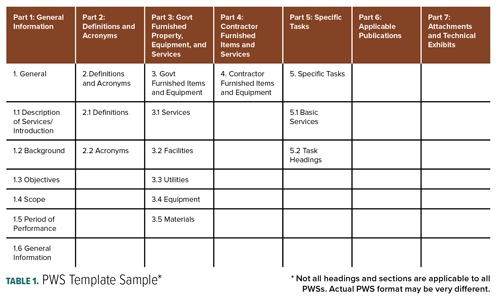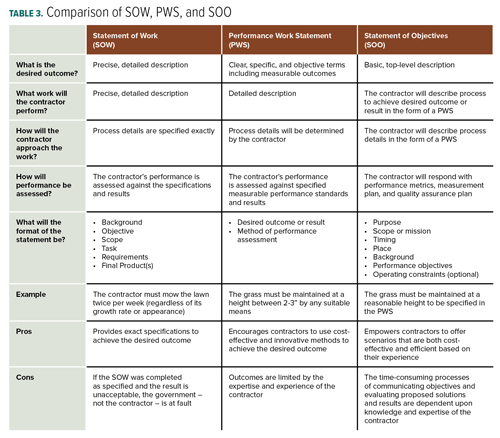Know What You’re Writing: SOW, PWS, or SOO
The performance work statement, statement of work, and statement of objectives may be similar in application, but their scope and focus are very different.
By Janet Arrowood
 As a buyer of goods and services, it is essential you have clear, easy-to-understand solicitation documents. Part of creating them is choosing among performance work statement (PWS), statement of work (SOW), or statement of objectives (SOO). Mixing elements of two or more of these documents often results in confusion, questions, and protests.
This article is written from the buyer’s perspective. But with a few seller-oriented considerations, the information applies to either entity.
Specific guidance for writing each document type is somewhat sparse, but there are several resources, including the Federal Acquisition Regulation (FAR),1 a Military Handbook (MIL-HDBK),2 and “A [Contracting Officer’s Representative] COR’s Guide to SOW, PWS, and SOO.”3 State and local governments and industry buyers may have similar guidance documents.4
As a buyer of goods and services, it is essential you have clear, easy-to-understand solicitation documents. Part of creating them is choosing among performance work statement (PWS), statement of work (SOW), or statement of objectives (SOO). Mixing elements of two or more of these documents often results in confusion, questions, and protests.
This article is written from the buyer’s perspective. But with a few seller-oriented considerations, the information applies to either entity.
Specific guidance for writing each document type is somewhat sparse, but there are several resources, including the Federal Acquisition Regulation (FAR),1 a Military Handbook (MIL-HDBK),2 and “A [Contracting Officer’s Representative] COR’s Guide to SOW, PWS, and SOO.”3 State and local governments and industry buyers may have similar guidance documents.4
Document Type Matters
The PWS, SOW, and SOO may be similar in application, but their scope and focus are very different.
Before addressing when to use the SOW or PWS, it is useful to understand what each is and how they differ.
The FAR does not define SOW. Various sources explain that SOW describes the work to be performed by the seller and directs the seller how to perform the work.
The PWS, on the other hand, is defined in the FAR. According to FAR 2.101, “Performance work statement means a statement of work for performance-based acquisitions that describes the required results in clear, specific and objective terms with measurable outcomes.” In other words, a PWS says what the seller needs to do, but does not say how to do the work. The PWS allows the seller to decide how to achieve the outcomes required by the buyer.
Procurement Approaches
The current procurement approach for service contracts favored by the federal government, many state and local governments, and much of industry is performance-based acquisition (PBA). Using PBA, the buyer creates a PWS, or a SOO from which the seller creates their pro-posed PWS. The seller assumes the responsibility for quality, completeness, cost, and schedule adherence. If the terms of the PWS are met, the buyer must accept the end result.
The SOW is the traditional procurement approach used for both goods and services. The buyer maintains control, and in conjunction with specifications, details precisely what is wanted from and expected of the seller. The buyer also assumes responsibility for quality, completeness, cost, and schedule adherence so long as the seller follows the SOW to the letter.
Choosing and Writing a PWS
To develop a PWS, the buyer’s procurement team must have an agreed approach to meeting the needs, goals, and outcomes for the project. The PWS needs to be developed in terms of three key questions:
· What do I need?
· When do I need it?
· How do I know the end result is good when I receive it?
A PWS has several mandatory features:
· The buyer must state the work required in terms of outcomes rather than method of performance.
· The buyer must provide measurable performance standards and indicate the method to be used to measure performance against those standards.
· The buyer is responsible for managing quality control/quality assurance to ensure performance standards are met.
For the PWS, once you have identified your set of performance standards, apply the SMART test by asking whether the measures and outcomes are:
· Specific
· Measurable
· Attainable
· Relevant
· Timely
To ensure your PWS is complete, include or consider the following:
· Provide a complete definition of the work requirements.
· Reference only the minimum applicable specifications and standards needed.
· Avoid directing how tasks are to be performed; state only the required results.
· Avoid detailed job descriptions for key personnel.
· Write in clear, concise, plain language, using active voice and minimizing adjectives, prepositional phrases, and pronouns. This approach minimizes seller questions and misinterpretation by either party.
· Ensure obligations, expectations, and deliverables are clearly defined and explained.
· Identify acceptance criteria to ensure desired outcomes are achieved.
· Tie deliverables to seller payments.
 Using a PWS can encourage innovation and effectiveness on the part of sellers. Additionally, developing a PWS requires less research and work for the buyer since the heavy lifting of determining how to perform falls to sellers.
The FAR (Sub-part 37-6) provides a general template, usable by any buyer, for the PWS, as provided in Table 1. Using this template and allocating key requirements and other items to a specific section helps ensure the PWS is logical, organized, and not repetitive.
Using a PWS can encourage innovation and effectiveness on the part of sellers. Additionally, developing a PWS requires less research and work for the buyer since the heavy lifting of determining how to perform falls to sellers.
The FAR (Sub-part 37-6) provides a general template, usable by any buyer, for the PWS, as provided in Table 1. Using this template and allocating key requirements and other items to a specific section helps ensure the PWS is logical, organized, and not repetitive.
Choosing and Writing a SOW
The SOW usually includes a long list of “musts” and “must nots.” It provides detailed descriptions, diagrams, and directions for all aspects of contract performance. The SOW is very specifications-driven and -focused. Rather than order a basic, readily available hammer, the buyer tells the seller the size, weight, length, diameter, tensile strength, type of metal, color, and so forth. In the worst case, the seller must retool its production line to produce these very specialized hammers, resulting in the buyer paying $900 for something the local hardware store sells for $10 or $20.
The SOW should specify in clear, concise, simple, and understandable terms the work to be done in developing or producing the goods to be delivered or services to be performed by a seller.
Preparation of an effective SOW requires both an understanding of the goods or services that are needed to satisfy a particular requirement and an ability to define what is required in specific, performance-based, quantitative terms. A SOW prepared in explicit terms will enable offerors to clearly understand the buyer’s needs and facilitate preparation of responsive proposals and delivery of the required goods or services.
A well-written SOW also aids the buyer when conducting seller selection and contract administration.5
Specific qualitative or quantitative technical requirements should not be spelled out in the SOW. For example, the specification may cite reliability and maintainability requirements in terms of quantifiable mean time between failures and mean time to repair. The SOW should task the seller to establish, implement, and control a reliability and maintainability program.6
Table 2 is a sample format for a SOW.

Choosing and Writing an SOO
In an era of rapid technological change, sellers often are better positioned to know and deploy state of art products and practices. They often are best qualified to provide viable solutions by creating the PWS from the buyer’s SOO. Shifting PWS development away from the buyer expands the field of potential sellers, thus increasing competition.
The SOO is a buyer-prepared document that provides the top-level objectives of the acquisition. It takes the place of a PWS in a solicitation. Sellers’ proposals contain their versions of the PWS and proposed scope of work, along with performance metrics, outcomes, and measures.
Comparing the Options
The decision as to which document to use is driven by the buyer’s requirements. If there is a specific procedure needed, or defined equipment required to fit with other services, goods, or products, an SOW usually is chosen. The SOW mandates that the seller must follow a prescribed procedure and cannot deviate. If there is not a specific procedure that must be followed, a PWS often gives better results at a lower cost.
Following are a few highlights and potential benefits of choosing a PWS or SOW:
PWS: The PWS approach increases the likelihood of meeting buyer needs. This approach is focused on intended results, not processes. Giving the seller more freedom to innovate and take risks increases seller buy-in and supports shared buyer and seller interests and goals. The PWS approach includes seller incentives, further supporting the seller’s ability to innovate and perform at maximum effectiveness.
SOW: When the goal is to tell the seller exactly what the buyer is seeking and how the buyer wants the work done, the SOW is the vehicle of choice. The SOW conveys to the seller precisely what the buyer wants. The buyer specifies the requirements that will control the seller’s process. The buyer is responsible for the performance since it directs the project and specifies the details.
SOO: Using the SOO simplifies the buyer’s tasks and is especially useful when the specifics of the service can, and probably should, be left to the seller to determine. The actual PWS (or sometimes the SOW) is created by the seller.
Table 3 is a simple comparison of the main features and considerations for the SOW, PWS, and SOO.7

Avoiding Confusion
Taking the time to carefully analyze the buyer’s project and user requirements is essential to choosing among PWS, SOW, or SOO. When requirements are clear, detailed, and essential to a successful project, the SOW might be the best choice. However, when the buyer has flexibility and is outcome- and performance-driven, letting industry (the sellers) determine what approach will best fulfill the need can be very cost effective and greatly increase the pool of potential sellers. Many service-based solicitations can benefit from the buyer creating a simple SOO and shifting the development of the PWS (or possible SOW) to the sellers.
Choosing the “wrong” option can lead to confusion, fewer sellers, excessive cost, schedule issues, numerous requests for clarification or questions, contract disputes, and more.
Choose wisely. Your project or program success depends on it. CM
Janet Arrowood has been a writer, technical editor, and writing trainer for more than 35 years. Arrowood is a mathematician by degree, an engineer by training, and a writer by profession. She specializes in training professionals, engineers, and contract specialists “how to write in plain English.”
ENDNOTES
https://www.acquisition.gov/far/subpart-37.6
https://acqnotes.com/Attachments/MIL-HDBK-245D%20DoD%20Handbook%20for%20Preparation%20of%20Statement%20of%20Work,%201996.pdf
https://acqnotes.com/wp-content/uploads/2014/09/A-CORs-Guide-to-Statement-of-Work.pdf
Note that procurements by other than the federal government often use the acronym, “SOW,” to mean “Scope of Work” rather than “statement of work.” There are significant differences in the two applications of “SOW,” so it is essential to be clear and only use the acronym for one meaning.
MIL-HDBK-245D
IBID
https://www.navsup.navy.mil/site/public/flcph/documents/contracting/cor_guides/A_CORs_Guide_to_SOW_PWS_and_SOO.pdf The referenced table is no longer online but is/was a government document